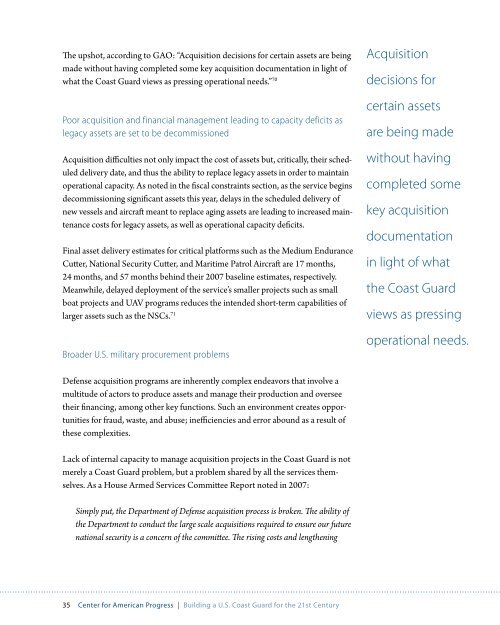Building a U.S. Coast Guard for the 21st Century - Center for ...
Building a U.S. Coast Guard for the 21st Century - Center for ...
Building a U.S. Coast Guard for the 21st Century - Center for ...
You also want an ePaper? Increase the reach of your titles
YUMPU automatically turns print PDFs into web optimized ePapers that Google loves.
The upshot, according to GAO: “Acquisition decisions <strong>for</strong> certain assets are being<br />
made without having completed some key acquisition documentation in light of<br />
what <strong>the</strong> <strong>Coast</strong> <strong>Guard</strong> views as pressing operational needs.” 70<br />
Poor acquisition and financial management leading to capacity deficits as<br />
legacy assets are set to be decommissioned<br />
Acquisition difficulties not only impact <strong>the</strong> cost of assets but, critically, <strong>the</strong>ir scheduled<br />
delivery date, and thus <strong>the</strong> ability to replace legacy assets in order to maintain<br />
operational capacity. As noted in <strong>the</strong> fiscal constraints section, as <strong>the</strong> service begins<br />
decommissioning significant assets this year, delays in <strong>the</strong> scheduled delivery of<br />
new vessels and aircraft meant to replace aging assets are leading to increased maintenance<br />
costs <strong>for</strong> legacy assets, as well as operational capacity deficits.<br />
Final asset delivery estimates <strong>for</strong> critical plat<strong>for</strong>ms such as <strong>the</strong> Medium Endurance<br />
Cutter, National Security Cutter, and Maritime Patrol Aircraft are 17 months,<br />
24 months, and 57 months behind <strong>the</strong>ir 2007 baseline estimates, respectively.<br />
Meanwhile, delayed deployment of <strong>the</strong> service’s smaller projects such as small<br />
boat projects and UAV programs reduces <strong>the</strong> intended short-term capabilities of<br />
larger assets such as <strong>the</strong> NSCs. 71<br />
Broader U.S. military procurement problems<br />
Defense acquisition programs are inherently complex endeavors that involve a<br />
multitude of actors to produce assets and manage <strong>the</strong>ir production and oversee<br />
<strong>the</strong>ir financing, among o<strong>the</strong>r key functions. Such an environment creates opportunities<br />
<strong>for</strong> fraud, waste, and abuse; inefficiencies and error abound as a result of<br />
<strong>the</strong>se complexities.<br />
Lack of internal capacity to manage acquisition projects in <strong>the</strong> <strong>Coast</strong> <strong>Guard</strong> is not<br />
merely a <strong>Coast</strong> <strong>Guard</strong> problem, but a problem shared by all <strong>the</strong> services <strong>the</strong>mselves.<br />
As a House Armed Services Committee Report noted in 2007:<br />
Simply put, <strong>the</strong> Department of Defense acquisition process is broken. The ability of<br />
<strong>the</strong> Department to conduct <strong>the</strong> large scale acquisitions required to ensure our future<br />
national security is a concern of <strong>the</strong> committee. The rising costs and leng<strong>the</strong>ning<br />
35 <strong>Center</strong> <strong>for</strong> American Progress | <strong>Building</strong> a U.S. <strong>Coast</strong> <strong>Guard</strong> <strong>for</strong> <strong>the</strong> <strong>21st</strong> <strong>Century</strong><br />
Acquisition<br />
decisions <strong>for</strong><br />
certain assets<br />
are being made<br />
without having<br />
completed some<br />
key acquisition<br />
documentation<br />
in light of what<br />
<strong>the</strong> <strong>Coast</strong> <strong>Guard</strong><br />
views as pressing<br />
operational needs.









